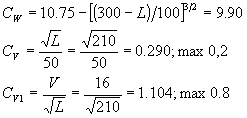[Front page] [Contents] [Previous] [Next] |
Modern Windships; Phase 2
Appendix 5. Calculation of Ship Motions and Accelerations
According to DNV, Volume 1, Pt. 3, Ch. 1, Sec. 4
Ship design factors given from the ship designers:
Surge, sway/yaw and heave accelerations: {B300}
Roll motion and acceleration: {B400}
Pitch motion and acceleration: {B500}
Combined vertical acceleration: {B600}
Combined transverse acceleration: {B700}
Combined longitudinal acceleration: {B800}
Combination between acceleration in different directions
Vertical and transverse force: {C500}
Vertical and longitudinal force:
Ship design factors given from the ship designers:
L=210 m
V=16 knots
D=19 m
T=12 m
CB=0.738
k=1.2
Surge, sway/yaw and heave accelerations: {B300}
The surge acceleration is given by:
![]()
![]()

The combined sway/yaw acceleration is given by:
![]()
The heave acceleration is given by:
![]()
Roll motion and acceleration: {B400}
Roll angle is given by:
![]()
![]()
The period of roll is given by:
![]()
![]()
z = distance from the baseline to the roll axis of rotation

The tangential roll acceleration at the height, h above the baseline is given by:

Pitch motion and acceleration: {B500}
Pitch angle is given by:
![]()
The period of pitch is given by:

The tangential pitch acceleration at the length, l from the A.P. is given by:
![]()
Combined vertical acceleration: {B600}

Combined transverse acceleration: {B700}
![]()
Since we want to have ary given as an angular acceleration and ay is small compared to the other terms, the transverse acceleration is calculated as:
![]() Forsat
Forsat

Combined longitudinal acceleration: {B800}
![]() Forsat
Forsat
![]()
Combination between acceleration in different directions
Vertical and transverse force: {C500}
Vertical force:
![]()
Transverse force:
![]() Forsat
Forsat
![]()
Vertical and longitudinal force:
Vertical force:
![]()
Longitudinal force:
![]()
[Front page] [Contents] [Previous] [Next] [Top] |